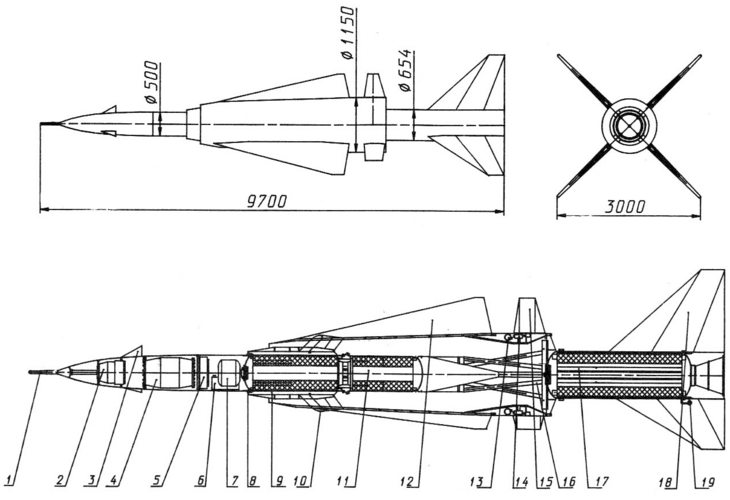I read that the Mk. IV version of the Bloodhound SAM was to be a mobile version. Anyone got any further details?
You are using an out of date browser. It may not display this or other websites correctly.
You should upgrade or use an alternative browser.
You should upgrade or use an alternative browser.
Bloodhound Mk IV SAM
- Thread starter GTX
- Start date
- Joined
- 28 November 2006
- Messages
- 699
- Reaction score
- 637
In Sweden each missile squadron had a peacetime site at its aviation flotille base, a training site and a number of combat sites that had been prepared in peacetime (some of which were placed along roads), they had basic infrastructure, mainly concrete pads for launchers and the unit's trucks and trailers. The system was mobile in a sense that the unit could have manouvered between the sites in order to avoid air strikes had a site's location been compromised. In total there were 34 missile sites in Sweden.
It should be noted that Sweden bought 48 launchers each with two missiles. So after firing the two the war would be over for the launcher's crew.
Below you may find some fotos showings parts of the Swedish Bloodhound (Rb 68 in their parlance).
Piotr
It should be noted that Sweden bought 48 launchers each with two missiles. So after firing the two the war would be over for the launcher's crew.
Below you may find some fotos showings parts of the Swedish Bloodhound (Rb 68 in their parlance).
Piotr
Attachments
-
 Rb 68 Column.png363.1 KB · Views: 388
Rb 68 Column.png363.1 KB · Views: 388 -
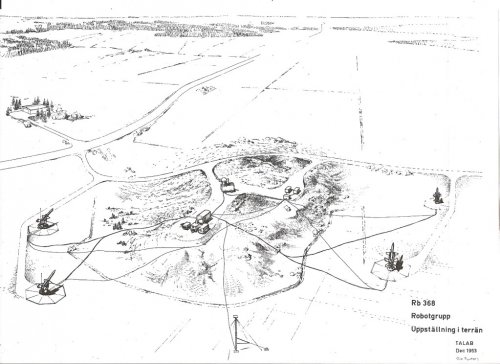 Rb 68 Combat Site (Field).jpg154.6 KB · Views: 211
Rb 68 Combat Site (Field).jpg154.6 KB · Views: 211 -
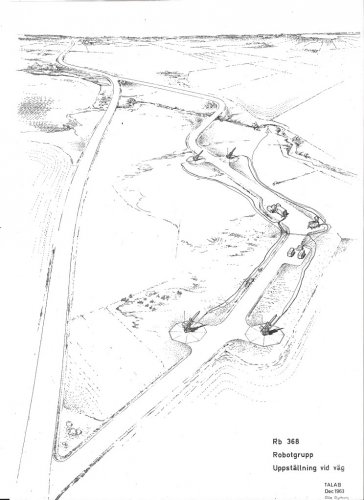 Rb 68 Combat Site (at Road).jpg136.7 KB · Views: 196
Rb 68 Combat Site (at Road).jpg136.7 KB · Views: 196 -
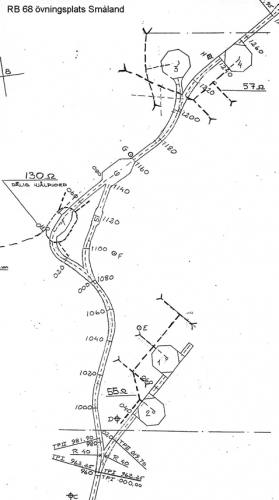 Rb 68 Training Site.png111 KB · Views: 195
Rb 68 Training Site.png111 KB · Views: 195 -
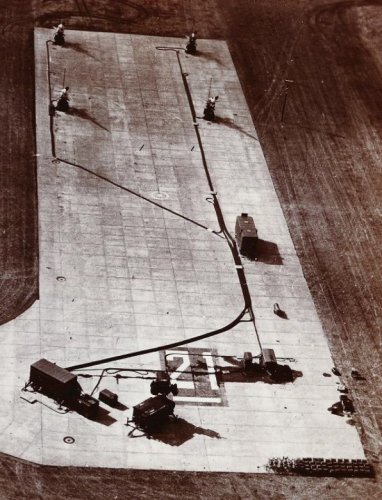 Rb 68 Peacetime Site 02.jpg198.1 KB · Views: 340
Rb 68 Peacetime Site 02.jpg198.1 KB · Views: 340 -
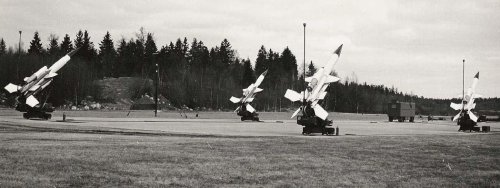 Rb 68 Peacetime Site 01.jpg172.9 KB · Views: 363
Rb 68 Peacetime Site 01.jpg172.9 KB · Views: 363 -
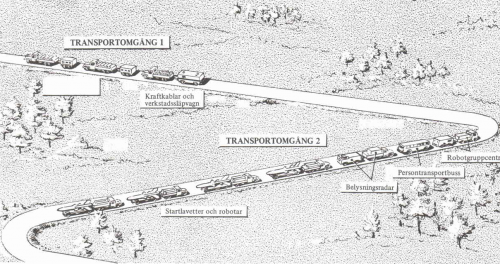 Rb 68 Column Sketch.png857.9 KB · Views: 383
Rb 68 Column Sketch.png857.9 KB · Views: 383 -
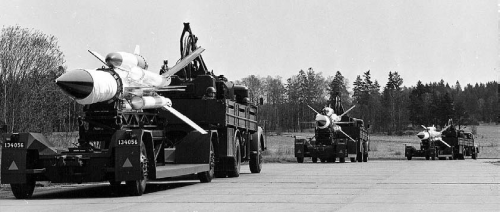 Rb 68 Missile Trailers.png290.5 KB · Views: 374
Rb 68 Missile Trailers.png290.5 KB · Views: 374
MainJAFAD
I really should change my personal text
- Joined
- 2 February 2015
- Messages
- 4
- Reaction score
- 8
Swedish Missile stocks were 116 missiles. 96 for the 12 weapon sections (10 operational and 2 training with four launchers per section and 8 missiles (four on launcher and four reloads)), 10 spare missiles to allow servicing of missile rotations and 10 missile with instrumented warhead missile modifications to allow the missile to be fired at the Swedish missile range at Vidsil. The later which were fully combat capable (all ten were fired during the life of the system in Swedish Service).Of the rest, 96 were sold back to the UK (66) and Switzerland (30) in the late 1970s and the rest became museum pieces. On top of that 10 Rb-365 Bloodhound 1's were modified to become Drill Rb-68 missile for loading training The Swedish missile numbers reflect what the RAF had. 377 missiles for 5 Missile Squadrons. 2 squadrons were planned to have 32 launchers on 4 missile sections (8 launchers per section) and 64 combat capable missiles (plus 8 to 16 spares for the servicing rotation and squadron missile firings at Aberporth). 2 Squadrons had 6 sections, 3 static with 8 launchers and 4 mobile with 4 launchers fitted with out riggers. Total combat capable missiles were 72 (36 on launcher), plus 8 to 16 spares and a training and trials Squadron with 3 sections (one mobile) each with 4 launchers and 15 missiles (fully combat capable with 12 hours notice). The rest were for service firing trials and modification proofing at Aberpoth. Swiss missile stocks 198 missiles for 8 operational weapon sections at 5 sites (all with 8 launchers per section) and a training site with four launchers (with an operational capability). 68 missiles on launcher, 68 reloads (136 operational missiles) plus 62 spares in reserve as they could only service 4 missiles at one time (the Swedish could only do 2 at one time and the RAF could do 8 to 10 at the same time as their missile servicing flights on the Squadrons were scaled for two missile overall test rigs per squadron).
Bloodhound VI, a back of a fag packet study instigated by Zuckermann in early March 1960 to axe one of the three land based SAM's under development for the RAF and the Army (Bloodhound 2,Bloodhound 3 and Thunderbird 2) to save money. The purpose of the study to make Bloodhound II mobile enough to met British Army requirements.
Plus points. Bloodhound II fully met War Office Requirements as regards Intercept Max Range and Max Altitude, plus ECCM requirements (in fact, far superior on all counts).
Minus points.
New light weight Launcher required.
New Missile Transport vehicle required
6 re-enginnered types of chassis required to carry all of the support equipment
total re-engineering of missile test and servicing equipment to allow mobile deployment.
The biggest issue was the Army didn't think the missile itself was rugged enough for deployment in the field, it was too large to transport on the standard 3 ton truck and it was not designed to be assembled out of the box in the field like Thunderbird was. The other minus point was the work required to modified Bloodhound II for Army use was going to delay deployment of a replacement for Thunderbird Mk1 by up to 2 1/2 years. Of course, by the time any major work had been done on this study, it was obsolete because the Defence Council axed Bloodhound Mk 3. In fact, Thunderbird II was so rugged and Squadie proof that when the they tested the new Con Rod warheads in the thing it was found that the rods broke apart as they tried to push through the warhead bay skins which total negated the effectiveness of the warhead. Thus a totally redesigned warhead bay was required, which was one of the things that delayed the missiles entry into service.
Bloodhound VI, a back of a fag packet study instigated by Zuckermann in early March 1960 to axe one of the three land based SAM's under development for the RAF and the Army (Bloodhound 2,Bloodhound 3 and Thunderbird 2) to save money. The purpose of the study to make Bloodhound II mobile enough to met British Army requirements.
Plus points. Bloodhound II fully met War Office Requirements as regards Intercept Max Range and Max Altitude, plus ECCM requirements (in fact, far superior on all counts).
Minus points.
New light weight Launcher required.
New Missile Transport vehicle required
6 re-enginnered types of chassis required to carry all of the support equipment
total re-engineering of missile test and servicing equipment to allow mobile deployment.
The biggest issue was the Army didn't think the missile itself was rugged enough for deployment in the field, it was too large to transport on the standard 3 ton truck and it was not designed to be assembled out of the box in the field like Thunderbird was. The other minus point was the work required to modified Bloodhound II for Army use was going to delay deployment of a replacement for Thunderbird Mk1 by up to 2 1/2 years. Of course, by the time any major work had been done on this study, it was obsolete because the Defence Council axed Bloodhound Mk 3. In fact, Thunderbird II was so rugged and Squadie proof that when the they tested the new Con Rod warheads in the thing it was found that the rods broke apart as they tried to push through the warhead bay skins which total negated the effectiveness of the warhead. Thus a totally redesigned warhead bay was required, which was one of the things that delayed the missiles entry into service.
Last edited:
Indeed - see following:Bloodhound IV was to be based on Swedish experience with making Bloodhound II mobile. In RAF service, Bloodhound was described as 'transportable' rather than 'mobile'.
Chris


T. A. Gardner
ACCESS: Top Secret
- Joined
- 18 February 2021
- Messages
- 878
- Reaction score
- 1,510
I don't know about the SA-4, but compared to Talos it was about as effective in terms of hitting a target, but only had about two-thirds the range at most (about 50 nm v. 75 nm). This was almost entirely due to the differences in guidance systems between the two.Any idea how Bloodhound performed compared to SA-4 Ganef and Talos?
Talos flies a ballistic trajectory to reach the target. This makes its flight as energy efficient as possible. Bloodhound flies a direct path riding the guidance beam (yes, it's semi-active homing, but in approach that makes it effectively a beam rider) which is less efficient.
The terminal guidance was different and this is what really limits the Bloodhound's range.
At the time (the 60's to 70's roughly) radar and sensor technology limited semi-active homing to around 50 nm at most simply due to the beam spreading as it went further from the transmitting station. Talos used a very complex and expensive lensed radar system along with the missile using an interferometer detection system that allowed good accuracy at very long ranges.
In terms of mission, I'd say Bloodhound is closer to BOMARC than Talos. Again, the USAF came up with an alternative for extremely long range intercepts with BOMARC. In that missile system ground tracking radar and flight control to the target area were handled by SAGE, again an incredibly expensive system that could fly the missile in autopilot to the target area. The missile was then fitted with its own active radar search and homing system that allowed it to find and intercept the target once close to it.
My off hand thoughts on the SA-4 is that it's less effective than the Western systems listed above, and that's based on the performance of Soviet era SAM's in actual use in combat.
- Joined
- 21 May 2006
- Messages
- 2,703
- Reaction score
- 1,604
Whilst on the subject of comparing Bloodhound and 2K11, and although a little off topic, I just stumbled across the following in terms of the 2K11:I don't know about the SA-4, but compared to Talos it was about as effective in terms of hitting a target, but only had about two-thirds the range at most (about 50 nm v. 75 nm). This was almost entirely due to the differences in guidance systems between the two.Any idea how Bloodhound performed compared to SA-4 Ganef and Talos?
Talos flies a ballistic trajectory to reach the target. This makes its flight as energy efficient as possible. Bloodhound flies a direct path riding the guidance beam (yes, it's semi-active homing, but in approach that makes it effectively a beam rider) which is less efficient.
The terminal guidance was different and this is what really limits the Bloodhound's range.
At the time (the 60's to 70's roughly) radar and sensor technology limited semi-active homing to around 50 nm at most simply due to the beam spreading as it went further from the transmitting station. Talos used a very complex and expensive lensed radar system along with the missile using an interferometer detection system that allowed good accuracy at very long ranges.
In terms of mission, I'd say Bloodhound is closer to BOMARC than Talos. Again, the USAF came up with an alternative for extremely long range intercepts with BOMARC. In that missile system ground tracking radar and flight control to the target area were handled by SAGE, again an incredibly expensive system that could fly the missile in autopilot to the target area. The missile was then fitted with its own active radar search and homing system that allowed it to find and intercept the target once close to it.
My off hand thoughts on the SA-4 is that it's less effective than the Western systems listed above, and that's based on the performance of Soviet era SAM's in actual use in combat.
"Its NATO reporting name is SA-4 Ganef, after the Yiddish word גנבֿ meaning "thief"; the name was used because the system was a copy of the Bristol Bloodhound."
(Source: (Reference: "rocket and missile system | weapons system | Britannica" https://en.m.wikipedia.org/wiki/2K11_Krug)
Now granted, this is from Wikipedia, but is there any grounds for this claim that 2K11 was a copy of the Bloodhound, or was it one of those Cold War claims?
Regards
Pioneer
- Joined
- 3 June 2011
- Messages
- 17,300
- Reaction score
- 8,993
Have you looked at them?Whilst on the subject of comparing Bloodhound and 2K11, and although a little off topic, I just stumbled across the following in terms of the 2K11:I don't know about the SA-4, but compared to Talos it was about as effective in terms of hitting a target, but only had about two-thirds the range at most (about 50 nm v. 75 nm). This was almost entirely due to the differences in guidance systems between the two.Any idea how Bloodhound performed compared to SA-4 Ganef and Talos?
Talos flies a ballistic trajectory to reach the target. This makes its flight as energy efficient as possible. Bloodhound flies a direct path riding the guidance beam (yes, it's semi-active homing, but in approach that makes it effectively a beam rider) which is less efficient.
The terminal guidance was different and this is what really limits the Bloodhound's range.
At the time (the 60's to 70's roughly) radar and sensor technology limited semi-active homing to around 50 nm at most simply due to the beam spreading as it went further from the transmitting station. Talos used a very complex and expensive lensed radar system along with the missile using an interferometer detection system that allowed good accuracy at very long ranges.
In terms of mission, I'd say Bloodhound is closer to BOMARC than Talos. Again, the USAF came up with an alternative for extremely long range intercepts with BOMARC. In that missile system ground tracking radar and flight control to the target area were handled by SAGE, again an incredibly expensive system that could fly the missile in autopilot to the target area. The missile was then fitted with its own active radar search and homing system that allowed it to find and intercept the target once close to it.
My off hand thoughts on the SA-4 is that it's less effective than the Western systems listed above, and that's based on the performance of Soviet era SAM's in actual use in combat.
"Its NATO reporting name is SA-4 Ganef, after the Yiddish word גנבֿ meaning "thief"; the name was used because the system was a copy of the Bristol Bloodhound."
(Source: (Reference: "rocket and missile system | weapons system | Britannica" https://en.m.wikipedia.org/wiki/2K11_Krug)
Now granted, this is from Wikipedia, but is there any grounds for this claim that 2K11 was a copy of the Bloodhound, or was it one of those Cold War claims?
Regards
Pioneer
T. A. Gardner
ACCESS: Top Secret
- Joined
- 18 February 2021
- Messages
- 878
- Reaction score
- 1,510
Only cursorily. The SA-4 was developed after 1955 where my research on SAM's ends. I am doing what might be called the Gen 0 and 1 systems. That is the early predecessors that never went into service and the first generation of SAM's that did. Beyond that, the picture gets a lot more complicated and good information is not always available for reasons of secrecy on the part of the nations developing them. For example, a lot of stuff on Nike Hercules is still classified.Have you looked at them?Whilst on the subject of comparing Bloodhound and 2K11, and although a little off topic, I just stumbled across the following in terms of the 2K11:I don't know about the SA-4, but compared to Talos it was about as effective in terms of hitting a target, but only had about two-thirds the range at most (about 50 nm v. 75 nm). This was almost entirely due to the differences in guidance systems between the two.Any idea how Bloodhound performed compared to SA-4 Ganef and Talos?
Talos flies a ballistic trajectory to reach the target. This makes its flight as energy efficient as possible. Bloodhound flies a direct path riding the guidance beam (yes, it's semi-active homing, but in approach that makes it effectively a beam rider) which is less efficient.
The terminal guidance was different and this is what really limits the Bloodhound's range.
At the time (the 60's to 70's roughly) radar and sensor technology limited semi-active homing to around 50 nm at most simply due to the beam spreading as it went further from the transmitting station. Talos used a very complex and expensive lensed radar system along with the missile using an interferometer detection system that allowed good accuracy at very long ranges.
In terms of mission, I'd say Bloodhound is closer to BOMARC than Talos. Again, the USAF came up with an alternative for extremely long range intercepts with BOMARC. In that missile system ground tracking radar and flight control to the target area were handled by SAGE, again an incredibly expensive system that could fly the missile in autopilot to the target area. The missile was then fitted with its own active radar search and homing system that allowed it to find and intercept the target once close to it.
My off hand thoughts on the SA-4 is that it's less effective than the Western systems listed above, and that's based on the performance of Soviet era SAM's in actual use in combat.
"Its NATO reporting name is SA-4 Ganef, after the Yiddish word גנבֿ meaning "thief"; the name was used because the system was a copy of the Bristol Bloodhound."
(Source: (Reference: "rocket and missile system | weapons system | Britannica" https://en.m.wikipedia.org/wiki/2K11_Krug)
Now granted, this is from Wikipedia, but is there any grounds for this claim that 2K11 was a copy of the Bloodhound, or was it one of those Cold War claims?
Regards
Pioneer
- Joined
- 21 May 2006
- Messages
- 2,703
- Reaction score
- 1,604
Thanks for your speedy reply!Only cursorily. The SA-4 was developed after 1955 where my research on SAM's ends. I am doing what might be called the Gen 0 and 1 systems. That is the early predecessors that never went into service and the first generation of SAM's that did. Beyond that, the picture gets a lot more complicated and good information is not always available for reasons of secrecy on the part of the nations developing them. For example, a lot of stuff on Nike Hercules is still classified.Have you looked at them?Whilst on the subject of comparing Bloodhound and 2K11, and although a little off topic, I just stumbled across the following in terms of the 2K11:I don't know about the SA-4, but compared to Talos it was about as effective in terms of hitting a target, but only had about two-thirds the range at most (about 50 nm v. 75 nm). This was almost entirely due to the differences in guidance systems between the two.Any idea how Bloodhound performed compared to SA-4 Ganef and Talos?
Talos flies a ballistic trajectory to reach the target. This makes its flight as energy efficient as possible. Bloodhound flies a direct path riding the guidance beam (yes, it's semi-active homing, but in approach that makes it effectively a beam rider) which is less efficient.
The terminal guidance was different and this is what really limits the Bloodhound's range.
At the time (the 60's to 70's roughly) radar and sensor technology limited semi-active homing to around 50 nm at most simply due to the beam spreading as it went further from the transmitting station. Talos used a very complex and expensive lensed radar system along with the missile using an interferometer detection system that allowed good accuracy at very long ranges.
In terms of mission, I'd say Bloodhound is closer to BOMARC than Talos. Again, the USAF came up with an alternative for extremely long range intercepts with BOMARC. In that missile system ground tracking radar and flight control to the target area were handled by SAGE, again an incredibly expensive system that could fly the missile in autopilot to the target area. The missile was then fitted with its own active radar search and homing system that allowed it to find and intercept the target once close to it.
My off hand thoughts on the SA-4 is that it's less effective than the Western systems listed above, and that's based on the performance of Soviet era SAM's in actual use in combat.
"Its NATO reporting name is SA-4 Ganef, after the Yiddish word גנבֿ meaning "thief"; the name was used because the system was a copy of the Bristol Bloodhound."
(Source: (Reference: "rocket and missile system | weapons system | Britannica" https://en.m.wikipedia.org/wiki/2K11_Krug)
Now granted, this is from Wikipedia, but is there any grounds for this claim that 2K11 was a copy of the Bloodhound, or was it one of those Cold War claims?
Regards
Pioneer
Look forward to your continuing research with baited breath.
Regards
Pioneer
- Joined
- 21 May 2006
- Messages
- 2,703
- Reaction score
- 1,604
Yes I have my dear sferrin, and by that, I assume you mean the four strap-on rocket boosters?Have you looked at them?Whilst on the subject of comparing Bloodhound and 2K11, and although a little off topic, I just stumbled across the following in terms of the 2K11:I don't know about the SA-4, but compared to Talos it was about as effective in terms of hitting a target, but only had about two-thirds the range at most (about 50 nm v. 75 nm). This was almost entirely due to the differences in guidance systems between the two.Any idea how Bloodhound performed compared to SA-4 Ganef and Talos?
Talos flies a ballistic trajectory to reach the target. This makes its flight as energy efficient as possible. Bloodhound flies a direct path riding the guidance beam (yes, it's semi-active homing, but in approach that makes it effectively a beam rider) which is less efficient.
The terminal guidance was different and this is what really limits the Bloodhound's range.
At the time (the 60's to 70's roughly) radar and sensor technology limited semi-active homing to around 50 nm at most simply due to the beam spreading as it went further from the transmitting station. Talos used a very complex and expensive lensed radar system along with the missile using an interferometer detection system that allowed good accuracy at very long ranges.
In terms of mission, I'd say Bloodhound is closer to BOMARC than Talos. Again, the USAF came up with an alternative for extremely long range intercepts with BOMARC. In that missile system ground tracking radar and flight control to the target area were handled by SAGE, again an incredibly expensive system that could fly the missile in autopilot to the target area. The missile was then fitted with its own active radar search and homing system that allowed it to find and intercept the target once close to it.
My off hand thoughts on the SA-4 is that it's less effective than the Western systems listed above, and that's based on the performance of Soviet era SAM's in actual use in combat.
"Its NATO reporting name is SA-4 Ganef, after the Yiddish word גנבֿ meaning "thief"; the name was used because the system was a copy of the Bristol Bloodhound."
(Source: (Reference: "rocket and missile system | weapons system | Britannica" https://en.m.wikipedia.org/wiki/2K11_Krug)
Now granted, this is from Wikipedia, but is there any grounds for this claim that 2K11 was a copy of the Bloodhound, or was it one of those Cold War claims?
Regards
Pioneer
But looks alone are deceiving are they not, as was the operational requirements of the British and Soviets.
Regards
Pioneer
- Joined
- 26 May 2011
- Messages
- 2,105
- Reaction score
- 2,677
I don't know how true that story is, but I got the impression that Ganef was assigned because the SA-4 was ramjet powered, rather than the four strap-on boost motors. i.e. the Soviets had nicked the idea for a long range ramjet missile.
Could be a Gunstonian tall tale to add a little to a random designation/reporting name assignment. Quite unusual to assign a reporting name based on a characteristic.
Chris
Could be a Gunstonian tall tale to add a little to a random designation/reporting name assignment. Quite unusual to assign a reporting name based on a characteristic.
Chris
Dilandu
I'm dissatisfied, which means, I exist.
USSR worked on ramjet-powered surface-to-air missiles - initially for S-75 Dvina system - since mid-1950s. Western examples weren't exactly the inspiration: more a confirmation, that the idea of ramjet SAM worth further development. And must point out, that "Krug" (Ganef) with its integral ramjet, have very little in common with Bloodhound. It was based on experimental ramjet missile developed for S-75 in 1958:the Soviets had nicked the idea for a long range ramjet missile.
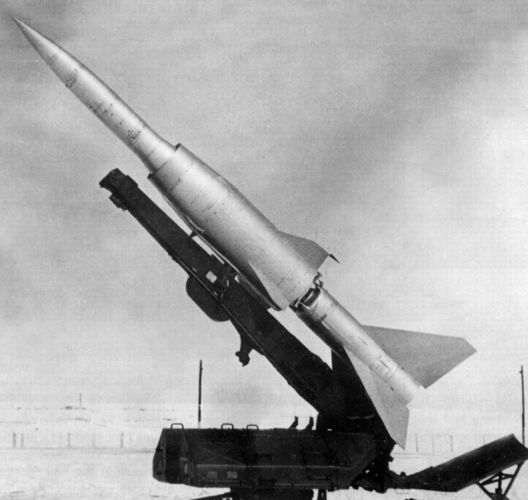
Dilandu
I'm dissatisfied, which means, I exist.
There was an experimental missile for S-75 with external ramjets - the 22D - but it was rather unusual three stage SAM (ŕocket-ramjet-rocket). The external ramjets were used only because the body of the missile was occupied by third-stage rocket engine. The idea was, that second-stage ramjets (solid-fuel) would gave missile the range, and third-stage rocket would give a terminal boost against high-altitude targets.

The 22D missile was tested sucsessfully, but its range was greater than standard S-75 fire control system could handle. At the same time, a longer range modification of standard, liquid fuel rocket S-75 became available, so the ramjet powered 22D was dropped.
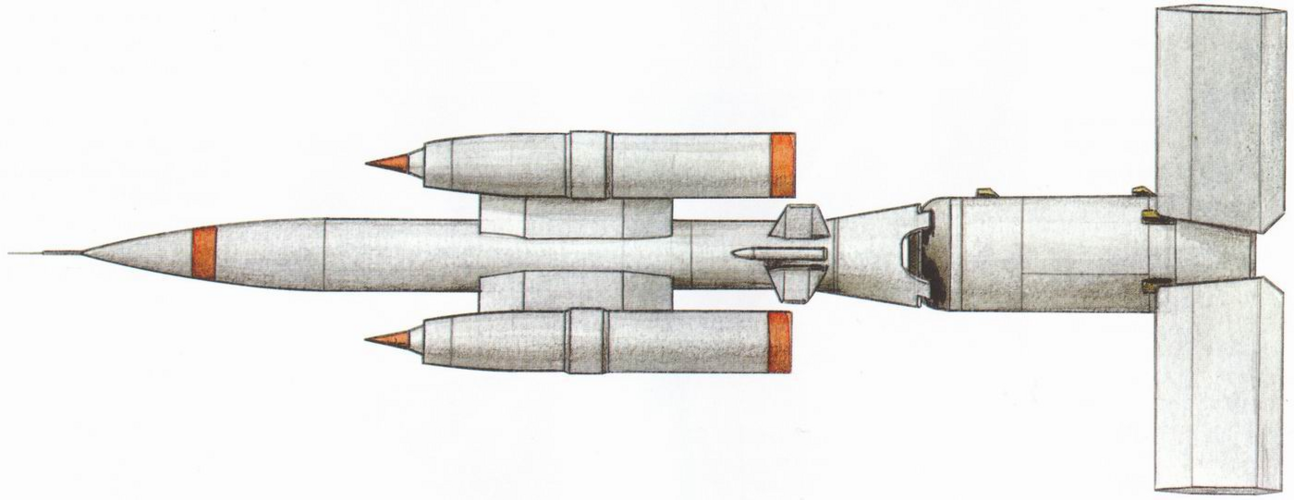
The 22D missile was tested sucsessfully, but its range was greater than standard S-75 fire control system could handle. At the same time, a longer range modification of standard, liquid fuel rocket S-75 became available, so the ramjet powered 22D was dropped.
For example, a lot of stuff on Nike Hercules is still classified.
I find that surprising given the MIM-14's age and that it has been out of service for decades.
Yellow Palace
ACCESS: Top Secret
- Joined
- 5 May 2007
- Messages
- 1,021
- Reaction score
- 1,639
I don't - see my comment in another thread about declassification not happening by default. It only gets declassified when someone wants it done, and the resources to make it happen are available.For example, a lot of stuff on Nike Hercules is still classified.
I find that surprising given the MIM-14's age and that it has been out of service for decades.
- Joined
- 21 May 2006
- Messages
- 2,703
- Reaction score
- 1,604
Thanks Dilandu, can't say I've ever seen this design beforeUSSR worked on ramjet-powered surface-to-air missiles - initially for S-75 Dvina system - since mid-1950s. Western examples weren't exactly the inspiration: more a confirmation, that the idea of ramjet SAM worth further development. And must point out, that "Krug" (Ganef) with its integral ramjet, have very little in common with Bloodhound. It was based on experimental ramjet missile developed for S-75 in 1958:the Soviets had nicked the idea for a long range ramjet missile.
View attachment 682080
Did it have a particular designation?
Regards
Pioneer
Dilandu
I'm dissatisfied, which means, I exist.
They were nuclear-equipped; presumably, the classified data is about parts relatedvto nuclear warheads.I find that surprising given the MIM-14's age and that it has been out of service for decades.
They were nuclear-equipped; presumably, the classified data is about parts relatedvto nuclear warheads.I find that surprising given the MIM-14's age and that it has been out of service for decades.
While you are correct about the nuclear-warheads those particular missiles only made up a small fraction of the MIM-14s.
Dilandu
I'm dissatisfied, which means, I exist.
Dilandu
I'm dissatisfied, which means, I exist.
At least 2550 warheads of W-31 type were specifically produced to Nike-Hercules. So about 10% of all Nike-Hercules (total producion circa 25000 units) were nuclear. Not exactly a small fraction.While you are correct about the nuclear-warheads those particular missiles only made up a small fraction of the MIM-14s.
- Joined
- 3 June 2011
- Messages
- 17,300
- Reaction score
- 8,993
Yet still numbered over 2,500.They were nuclear-equipped; presumably, the classified data is about parts relatedvto nuclear warheads.I find that surprising given the MIM-14's age and that it has been out of service for decades.
While you are correct about the nuclear-warheads those particular missiles only made up a small fraction of the MIM-14s.
The only thing they have in common is the four-booster configuration, which was not uncommon in those days.Only cursorily. The SA-4 was developed after 1955 where my research on SAM's ends. I am doing what might be called the Gen 0 and 1 systems. That is the early predecessors that never went into service and the first generation of SAM's that did. Beyond that, the picture gets a lot more complicated and good information is not always available for reasons of secrecy on the part of the nations developing them. For example, a lot of stuff on Nike Hercules is still classified.Have you looked at them?Whilst on the subject of comparing Bloodhound and 2K11, and although a little off topic, I just stumbled across the following in terms of the 2K11:I don't know about the SA-4, but compared to Talos it was about as effective in terms of hitting a target, but only had about two-thirds the range at most (about 50 nm v. 75 nm). This was almost entirely due to the differences in guidance systems between the two.Any idea how Bloodhound performed compared to SA-4 Ganef and Talos?
Talos flies a ballistic trajectory to reach the target. This makes its flight as energy efficient as possible. Bloodhound flies a direct path riding the guidance beam (yes, it's semi-active homing, but in approach that makes it effectively a beam rider) which is less efficient.
The terminal guidance was different and this is what really limits the Bloodhound's range.
At the time (the 60's to 70's roughly) radar and sensor technology limited semi-active homing to around 50 nm at most simply due to the beam spreading as it went further from the transmitting station. Talos used a very complex and expensive lensed radar system along with the missile using an interferometer detection system that allowed good accuracy at very long ranges.
In terms of mission, I'd say Bloodhound is closer to BOMARC than Talos. Again, the USAF came up with an alternative for extremely long range intercepts with BOMARC. In that missile system ground tracking radar and flight control to the target area were handled by SAGE, again an incredibly expensive system that could fly the missile in autopilot to the target area. The missile was then fitted with its own active radar search and homing system that allowed it to find and intercept the target once close to it.
My off hand thoughts on the SA-4 is that it's less effective than the Western systems listed above, and that's based on the performance of Soviet era SAM's in actual use in combat.
"Its NATO reporting name is SA-4 Ganef, after the Yiddish word גנבֿ meaning "thief"; the name was used because the system was a copy of the Bristol Bloodhound."
(Source: (Reference: "rocket and missile system | weapons system | Britannica" https://en.m.wikipedia.org/wiki/2K11_Krug)
Now granted, this is from Wikipedia, but is there any grounds for this claim that 2K11 was a copy of the Bloodhound, or was it one of those Cold War claims?
Regards
Pioneer
T. A. Gardner
ACCESS: Top Secret
- Joined
- 18 February 2021
- Messages
- 878
- Reaction score
- 1,510
It mostly has to do with its ABM and nuclear capabilities.For example, a lot of stuff on Nike Hercules is still classified.
I find that surprising given the MIM-14's age and that it has been out of service for decades.
T. A. Gardner
ACCESS: Top Secret
- Joined
- 18 February 2021
- Messages
- 878
- Reaction score
- 1,510
That and its ABM capability.They were nuclear-equipped; presumably, the classified data is about parts relatedvto nuclear warheads.I find that surprising given the MIM-14's age and that it has been out of service for decades.
RHVERNON
I really should change my personal text
- Joined
- 8 October 2016
- Messages
- 15
- Reaction score
- 54
Bloodhound was not a Beam Rider!!! Talos was, with SARH terminal Homing in later models. Bloodhound 1 was Pulse SARH with Lock on before launch and full prop nav from booster separation and wing unlock. The longest range successful firing at Woomera was an impact range of 24 NM (the longest range unsuccessful shot was 28NM, but the missile suffered an infight malfunction). The Bloodhound 1 did fly up to the target's altitude and then level off. Due to the filtering done on the guidance to minimize wing movement (to reduce drag), it would then dip back down until the guidance system realised the missile was off target (in pitch) and the missile would pitch back up to make the intercept.I don't know about the SA-4, but compared to Talos it was about as effective in terms of hitting a target, but only had about two-thirds the range at most (about 50 nm v. 75 nm). This was almost entirely due to the differences in guidance systems between the two.Any idea how Bloodhound performed compared to SA-4 Ganef and Talos?
Talos flies a ballistic trajectory to reach the target. This makes its flight as energy efficient as possible. Bloodhound flies a direct path riding the guidance beam (yes, it's semi-active homing, but in approach that makes it effectively a beam rider) which is less efficient.
The terminal guidance was different and this is what really limits the Bloodhound's range.
At the time (the 60's to 70's roughly) radar and sensor technology limited semi-active homing to around 50 nm at most simply due to the beam spreading as it went further from the transmitting station. Talos used a very complex and expensive lensed radar system along with the missile using an interferometer detection system that allowed good accuracy at very long ranges.
In terms of mission, I'd say Bloodhound is closer to BOMARC than Talos. Again, the USAF came up with an alternative for extremely long range intercepts with BOMARC. In that missile system ground tracking radar and flight control to the target area were handled by SAGE, again an incredibly expensive system that could fly the missile in autopilot to the target area. The missile was then fitted with its own active radar search and homing system that allowed it to find and intercept the target once close to it.
My off hand thoughts on the SA-4 is that it's less effective than the Western systems listed above, and that's based on the performance of Soviet era SAM's in actual use in combat.
BAC did propose an upgrade to Bloodhound 1 in early 1957 that included bigger wings, Improved Gosling II or III boost motors and a simple Trajectory Control System that would get the missile up high in the early part of the flight and keep it there until a timer released the pitch control system to allow the missile to complete the intercept. Another improvement was an Accelerometer Assisted Range Gate which would allow the missile's guidance system to hold lock at much lower signal to noise ratios (mainly during the launch and boost phase of flight). This was hoped to be able to push the maximum range of the missile out to the maximum range of the Type 83 radar (45 to 50 NM for a Canberra).
However the Air Ministry was not interested and the only item from that list above that went into Bloodhound 1 was the AARG which was fitted as a mod in 1961.
Bloodhound 2 had a Trajectory Control System fitted to it and one of four Trajectory's could be selected by the LCP Computer before launch. The Trajectory control was switched off by a command signal from the ground 45 seconds before impact.
The Trajectory's were
1. Full prop nav from wing unlock. Maximum intercept range 15NM
2. Climb at 15 Degrees angle until Terminal Homing Command. Maximum intercept range 35NM
3. Climb at 40 Degrees angle and cruise at 40,000ft until Terminal Homing Command. Maximum intercept range 75NM
4. Climb at 40 Degrees angle and cruise at 55,000ft until Terminal Homing Command. Maximum intercept range 75NM
The third option gave the best missile maneuverability v range for a manoeuvring target, while the fourth one was for use against high altitude non manoeuvring targets (Bloodhound really didn't like doing really high altitude manoeuvring).
The longest range successful fight of a Bloodhound 2 was a 69 NM impact range shot at Woomera. Three firings at longer range failed due to a Radar Fault on the ground (Missile flew until the clock operated self destruct operated at 78NM (Clock could only run for 230 seconds, Missile could have flown under power for 255 seconds) and two shots at 93NM impact range which both failed de to missile malfunctions (one just after launch and the other ten seconds from intercept).
As a general built in rule on the computer software in the system it wouldn't allow an engagement over 75 NM.
Talos was, with SARH terminal Homing in later models.
All Talos variants with conventional HE warheads were equipped with SARH terminal-homing, the only variants that were beam-riding guidance only were the nuclear-warhead (The W-30) armed variants.
On another note what was the exact PN guidance law the Bloodhound used and do you know how it was implemented using analogue circuitry?
RHVERNON
I really should change my personal text
- Joined
- 8 October 2016
- Messages
- 15
- Reaction score
- 54
Nav Constant of 6 on the Mk 1, Mk 2 also used 6 for approaching or crossing targets, but had a Half Nav Constant (3) for receding targets. Nav Constant was added on the Pitch wing control channel only. The analogue circuitry for the Mk 1 was a resistor and diode network and transformer. Missile only did three manoeuvres, Roll Right. Roll Left and Pitch Up.
So a wave-shaping circuit with the transformer performing the multiplication.The analogue circuitry for the Mk 1 was a resistor and diode network and transformer.
No pitch down? Also were the control-fin servos bang-bang or proportional?Missile only did three manoeuvres, Roll Right. Roll Left and Pitch Up.
Do you have any links to the technical details if they're online or any technical documentation?
timmymagic
Forever disappointed in MoD procurement...
- Joined
- 23 August 2011
- Messages
- 1,026
- Reaction score
- 2,705
Weirdly this appeared on my twitter timeline today....Jaguars taking off from Bruggen (apparently flying East) with the 'dispersed' Bloodhound site..
View: https://twitter.com/clark_aviation/status/1579719948653527041
View: https://twitter.com/clark_aviation/status/1579719948653527041
- Joined
- 27 May 2008
- Messages
- 1,042
- Reaction score
- 2,000
No pitch down? Also were the control-fin servos bang-bang or proportional?Missile only did three manoeuvres, Roll Right. Roll Left and Pitch Up.
Do you have any links to the technical details if they're online or any technical documentation?
I understand the controls where proportional up until the terminal phase. Upon the final approach to the target the mode switched to using full control deflection. A Doppler distance measurement was incorporated to accurately measure when the switch over was commanded.
The ramjet locations were found to be pitch sensitive due to ingestion of dirty air being shed off the missile forebody, so the pitching rate was limited during cruise. However early testing showed this resulted in sizeable/unacceptable miss distances. Hence the enhanced (aggressive) terminal control deflection was introduced because at that point, keeping the ramjets happy was a secondary consideration compared to smashing into the target. By all accounts it worked very well.
Last edited:
- Joined
- 29 September 2006
- Messages
- 1,626
- Reaction score
- 1,022
Maybe pitch down is just Roll Right or Left 180 degrees then Pitch Up?So a wave-shaping circuit with the transformer performing the multiplication.The analogue circuitry for the Mk 1 was a resistor and diode network and transformer.
No pitch down? Also were the control-fin servos bang-bang or proportional?Missile only did three manoeuvres, Roll Right. Roll Left and Pitch Up.
Do you have any links to the technical details if they're online or any technical documentation?
T. A. Gardner
ACCESS: Top Secret
- Joined
- 18 February 2021
- Messages
- 878
- Reaction score
- 1,510
They share some similarities and lots of differences. The guidance systems are different, as are the missile flight controls. The Krug uses the more common cruciform wings working in pairs as opposed to Bloodhound's twist-steer pair of wings.Whilst on the subject of comparing Bloodhound and 2K11, and although a little off topic, I just stumbled across the following in terms of the 2K11:I don't know about the SA-4, but compared to Talos it was about as effective in terms of hitting a target, but only had about two-thirds the range at most (about 50 nm v. 75 nm). This was almost entirely due to the differences in guidance systems between the two.Any idea how Bloodhound performed compared to SA-4 Ganef and Talos?
Talos flies a ballistic trajectory to reach the target. This makes its flight as energy efficient as possible. Bloodhound flies a direct path riding the guidance beam (yes, it's semi-active homing, but in approach that makes it effectively a beam rider) which is less efficient.
The terminal guidance was different and this is what really limits the Bloodhound's range.
At the time (the 60's to 70's roughly) radar and sensor technology limited semi-active homing to around 50 nm at most simply due to the beam spreading as it went further from the transmitting station. Talos used a very complex and expensive lensed radar system along with the missile using an interferometer detection system that allowed good accuracy at very long ranges.
In terms of mission, I'd say Bloodhound is closer to BOMARC than Talos. Again, the USAF came up with an alternative for extremely long range intercepts with BOMARC. In that missile system ground tracking radar and flight control to the target area were handled by SAGE, again an incredibly expensive system that could fly the missile in autopilot to the target area. The missile was then fitted with its own active radar search and homing system that allowed it to find and intercept the target once close to it.
My off hand thoughts on the SA-4 is that it's less effective than the Western systems listed above, and that's based on the performance of Soviet era SAM's in actual use in combat.
"Its NATO reporting name is SA-4 Ganef, after the Yiddish word גנבֿ meaning "thief"; the name was used because the system was a copy of the Bristol Bloodhound."
(Source: (Reference: "rocket and missile system | weapons system | Britannica" https://en.m.wikipedia.org/wiki/2K11_Krug)
Now granted, this is from Wikipedia, but is there any grounds for this claim that 2K11 was a copy of the Bloodhound, or was it one of those Cold War claims?
Regards
Pioneer
The Krug uses a single, very large, ramjet engine and has almost double the speed of Bloodhound but about half the range. That both missiles are ramjet propelled is hardly one copying the other. During the period these missiles were developed, ramjets were used on a fair number of SAM's because they could get long range out of them. Some include: Talos, GAPA, BOMARC, Bloodhound, and the Krug.
The reason ramjets for these missiles fell out of popularity is the limitations on maneuvering that ramjets imposed. They couldn't perform tight radical maneuvers without high risk of the ramjet(s) flaming out while newer solid fuels for missiles gave performance that equaled or exceeded ramjet performance with the added bonus of being safer to handle and simpler to operate.
T. A. Gardner
ACCESS: Top Secret
- Joined
- 18 February 2021
- Messages
- 878
- Reaction score
- 1,510
Bristol got their Thor ramjet into service quickly and with little issue as they first looked at the US Marquardt designs, then got with Boeing and were able to use that company's data from their GAPA missile program (the 602 variant). Bristol did make several improvements and significant modifications to their design, the most important was changing the burner ignition system so it would provide a much longer burn time on the ramjet than what Boeing had devised. This gave Bloodhound it's long range.
the most important was changing the burner ignition system
Weren't the Bloodhound's ramjets pyrotechnically initiated?
T. A. Gardner
ACCESS: Top Secret
- Joined
- 18 February 2021
- Messages
- 878
- Reaction score
- 1,510
Initially it was a flare that burned for X number of seconds and that limited the range. This was changed to a gas burner that didn't go out until the missile reached its target meaning that range wasn't limited to engine run time. I assume the flare arrangement was copied from Boeing's GAPA and that missile was limited to about 35 NM of flight. The Brits wanted longer range so they ditched Boeing's solution for one of their own.the most important was changing the burner ignition system
Weren't the Bloodhound's ramjets pyrotechnically initiated?
T. A. Gardner
ACCESS: Top Secret
- Joined
- 18 February 2021
- Messages
- 878
- Reaction score
- 1,510
It's not so much "Mickey Mouse" as it is an odd choice originally used on Brakemine and kept afterwards. The amidships twist-steer was simpler than using a cruciform layout, but it had some serious limitations. Being roughly amidships on the missile it limited the maneuverability compared, in particular, to tail steered cruciform missiles.Personally I find the whole twist-and-steer arrangement to be a bit Mickey Mouse.
In part, it was kept on Bloodhound to deliberately reduce the turn rate and make the missile less maneuverable to prevent flameouts with the ramjets.
Against the intended targets--a moderately fast and non-maneuvering bomber--it was easily acceptable. Against a maneuvering small aircraft, it was going to have a hard time engaging it.
Similar threads
-
Swedish Missiles and Missile Projects.
- Started by Tzoli
- Replies: 22
-
-
-
-
Air launched Polaris and Pershing missiles
- Started by PMN1
- Replies: 21

